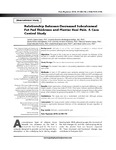Relationship Between Decreased Subcalcaneal Fat Pad Thickness and Plantar Heel Pain. A Case Control Study

Use este enlace para citar
http://hdl.handle.net/2183/30018
A non ser que se indique outra cousa, a licenza do ítem descríbese como Atribución-NoComercial 3.0 España
Coleccións
- Investigación (FEP) [507]
Metadatos
Mostrar o rexistro completo do ítemTítulo
Relationship Between Decreased Subcalcaneal Fat Pad Thickness and Plantar Heel Pain. A Case Control StudyAutor(es)
Data
2019-01Cita bibliográfica
Lopez-Lopez D, Becerro-de-Bengoa-Vallejo R, Losa-Iglesias ME, Soriano-Medrano A, Palomo-Lopez P, Morales-Ponce A, Rodriguez-Sanz D, Calvo-Lobo C. Relationship Between Decreased Subcalcaneal Fat Pad Thickness and Plantar Heel Pain. A Case Control Study. Pain Physician. 2019 Jan;22(1):109-116. PMID: 30700074.
Resumo
[Abstract] Background: Heel pain is one of the most frequent complaints in medical clinical practice for conditions affecting the feet during weight-bearing tasks.
Objective: The goal of this study was to measure and compare the thickness of the fat pad in a sample of patients with current unilateral heel pain and patients without unilateral heel pain with normalized reference parameters.
Study design: This was an observational case-control study.
Settings: The research took place in the podiatry department within a medical health care center.
Methods: A total of 375 patients were randomly selected from a pool of patients attending a medical health care center between the years 2008 and 2015 and diagnosed by a single medical podiatrist without having previous treatment. Patients were categorized in 2 groups: a heel pain group (n = 185) and a control group (asymptomatic; n = 190). The thickness of the plantar fat pad was measured with an ultrasonic probe (BodyMetrix® BX 2000; IntelaMetrix, Inc, Livermore, CA).
Results: Initial examination of both groups indicated no significant differences in age, height, weight, or body mass index (P > 0.01). There were, however, significant differences in the thickness of the fat pad between those in the heel pain group and those in the control group, when analyzed by group and by gender (P < 0.01; Cohen´s d = 0.465-1.959).
Limitations: The study was not a randomized controlled trial. Although primary outcome data were self-reported, the assessor was not blinded.
Conclusion: This study provides further evidence that people with unilateral heel pain showed a significantly decreased thickness of the subcalcaneal fat pad, regardless of gender.
Palabras chave
Heel pain
Dolor en el calcáneo
Subcalcaneal fat
Grasa subcalcánea
Pain
Dolor
Dolor en el calcáneo
Subcalcaneal fat
Grasa subcalcánea
Pain
Dolor
Dereitos
Atribución-NoComercial 3.0 España






